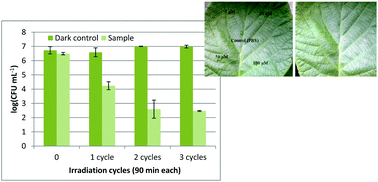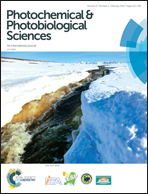An insight into the photodynamic approach versus copper formulations in the control of Pseudomonas syringae pv. actinidiae in kiwi plants
Abstract
In the last decade, the worldwide production of kiwi fruit has been highly affected by Pseudomonas syringae pv. actinidiae (Psa), a phytopathogenic bacterium; this has led to severe economic losses that are seriously affecting the kiwi fruit trade. The available treatments for this disease are still scarce, with the most common involving frequently spraying the orchards with copper derivatives, in particular cuprous oxide (Cu2O). However, these copper formulations should be avoided due to their high toxicity; therefore, it is essential to search for new approaches for controlling Psa. Antimicrobial photodynamic therapy (aPDT) may be an alternative approach to inactivate Psa. aPDT consists in the use of a photosensitizer molecule (PS) that absorbs light and by transference of the excess of energy or electrons to molecular oxygen forms highly reactive oxygen species (ROS) that can affect different molecular targets, thus being very unlikely to lead to the development of microbe resistance. The aim of the present study was to evaluate the effectiveness of aPDT to photoinactivate Psa, using the porphyrin Tetra-Py+-Me and different light intensities. The degree of inactivation of Psa was assessed using the PS at 5.0 μM under low irradiance (4.0 mW cm−2). Afterward, ex vivo experiments, using artificially contaminated kiwi leaves, were conducted with a PS at 50 μM under 150 mW cm−2 and sunlight irradiation. A reduction of 6 log in the in vitro assays after 90 min of irradiation was observed. In the ex vivo tests, the decrease was lower, approximately 1.8 log reduction at an irradiance of 150 mW cm−2, 1.2 log at 4.0 mW cm−2, and 1.5 log under solar radiation. However, after three successive cycles of treatment under 150 mW cm−2, a 4 log inactivation was achieved. No negative effects were observed on leaves after treatment. Assays using Cu2O were also performed at the recommended concentration by law (50 g h L−1) and at concentrations 10 times lower, in which at both concentrations, Psa was efficiently inactivated (5 log inactivation) after a few minutes of treatment, but negative effects were observed on the leaves after treatment.



 Please wait while we load your content...
Please wait while we load your content...